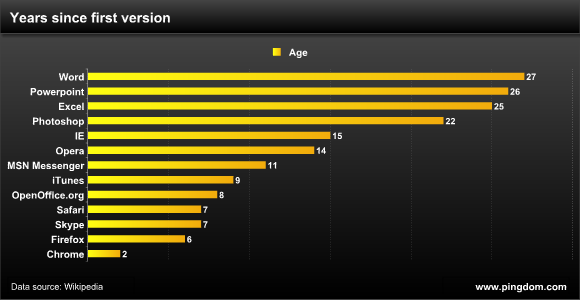 Think about the software you use day to day. Depending on your profession and interests, what you use will vary, but some applications tend to show up over and over again. Microsoft Word and Excel, Powerpoint, Photoshop, various web browsers like Internet Explorer and Firefox, Skype, iTunes, and so on.
Think about the software you use day to day. Depending on your profession and interests, what you use will vary, but some applications tend to show up over and over again. Microsoft Word and Excel, Powerpoint, Photoshop, various web browsers like Internet Explorer and Firefox, Skype, iTunes, and so on.
When it comes to those widely used, highly established desktop applications, think about how long it’s been since they first saw the light of day. Many of them are practically ancient.
To give you a taste of how old they actually are, we selected a sample of 12 popular desktop applications: Word, Powerpoint, Excel, Photoshop, Internet Explorer, Opera, MSN (Live) Messenger, iTunes, OpenOffice.org, Safari, Skype, Firefox, and Chrome.
So how long have these applications been around? We rounded up to the nearest full year:

Quick observations:
- The oldest of the bunch, Microsoft Word, has been around for 27 years.
- Four of the apps above have been around for more than 20 years.
- More than half have been around for over a decade.
- Only one has been around less than 5 years.
This is a small sample and isn’t meant as a deep statistical analysis. We just wanted to show that when it comes to widely-used, installed software (ignoring operating systems and web apps), most of the more popular applications have been around for a very long time.
The point is: There are very few new big hitters.
Mindshare domination
Today’s most established software applications have the benefit of having been around and continuously developed for many, many years. It can be pretty hard for newcomers to compete with the vast feature sets and the enormous mindshare these applications have accumulated. Creating a new Photoshop wouldn’t be easy.
If you look at operating systems it’s even worse. Even the relatively modern Mac OS X has strong ties back to good old BSD Unix and NeXT. Try launching a brand new operating system today… Good luck.
All this doesn’t mean that new applications aren’t successfully invading people’s desktops. Dropbox is a recent example of an app that is becoming quite popular. Google’s Chrome browser is another one. In less than two years Chrome has passed Apple’s Safari in terms of market share. Interestingly, both Dropbox and Chrome are tied to the web.
Which leads us to another question.
Installed apps vs. web apps
You can’t help but wonder if much of today’s innovation is simply happening online instead of on the desktop and if that is one of the reasons why our most popular desktop applications are so old. Developers are choosing to develop for a platform that is automatically cross platform (the web).
And there’s another huge upside to using the web as your platform: users don’t have to install anything. This makes the threshold for starting to use an application much lower, which makes it easier for new applications to gain users.
Could it be that the shift to running more apps online will prove to be the proverbial meteorite that finally wipes out the domination of the old desktop application dinosaurs…?
Photo credit: T-Rex by Scott Kinmartin.




























